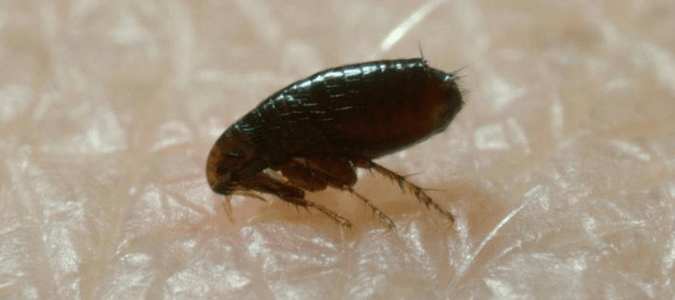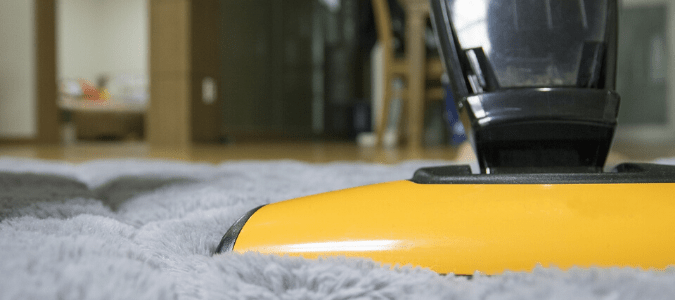
If you’ve ever had itchy bites on your skin and asked yourself whether they might be flea bites, you’ve probably also wondered what fleas look like. If you’ve never encountered these creatures before, you’re lucky, but also means you may be in the dark about whether you might have a flea problem. Unfortunately, fleas are so small and move so quickly, that they can be hard to spot, especially if you don’t know what you’re looking for. Fleas are about the same size and color as a speck of black pepper, and their eggs are smaller than grains of sand. Unless you have sharp eyesight, you could have fleas in your midst—even infesting your home—and not realize it.
Why should you worry about fleas? After all, while they do bite, they don’t carry or transmit diseases to humans or our pets as some types of insects do. But they are still a common problem in homes. For starters, their bites are itchy and annoying; people with sensitive skin might even develop an allergic reaction to flea bites. If you scratch flea bites too much, you could also develop a secondary infection that requires medical care to resolve.
These same problems are even more of an issue with our furry friends. Like humans, dogs and cats find flea bites to be itchy and irritating, and some pets have allergic reactions to flea bites that can lead to inflamed skin, hair loss and even mental health issues, such as anxiety and obsessive-compulsive behavior. Pets have also been known to develop anemia due to blood loss when they are unwitting hosts to lots of fleas. So although fleas aren’t disease carriers, they can still have a large and negative impact on the health and well-being of everyone living in the home.
Another problem with fleas is the fact that they are so prolific. Just a few fleas brought into your home, hidden in your pet’s fur, can turn into a full-blown infestation in a relatively short time, since a female flea can lay up to 2,000 eggs during her 100-day life. This explains how a seemingly “small” issue with fleas can very quickly grow out of control.
Adult fleas depend on blood from a host animal to survive, and they typically lay eggs in that animal’s fur. Since these eggs are tiny, round and smooth, they can easily drop out of your pet’s fur into its bedding, the carpet or cracks between floorboards, where they can remain for anywhere from a couple of days to a couple of weeks before hatching into flea larvae. Another handful of days or weeks later, the larvae become pupae, and then, after as little as a week or up to several months, they transform into adult fleas that are ready to reproduce. When conditions are favorable, the flea life cycle can take as little as just two weeks to complete.
Again, fleas can be hard to spot, and their eggs are almost impossible to see with the naked eye. Adult fleas move so quickly that some people wonder if fleas can fly, but the truth is that these creatures are actually wingless. Instead, they have six tiny, powerful legs that they can use to jump quite far—over a foot in distance, and more than six inches up into the air—so even if you spot one on your skin or in your pet’s fur, it can disappear in the blink of an eye.
If you notice your dog or cat scratching on a regular basis or if you find red, itchy bites on your own skin, it’s a sure sign that you could have a flea problem. People can be bitten anywhere by a flea, but these bites are most often found on the feet or ankles, since fleas can jump far, but not all that high. You can also check your pet’s fur and bedding for other signs of a flea infestation, including red, irritated bites and “flea dirt”—what looks like tiny, black specks of dirt in the pet’s fur. Both bites and flea dirt are often concentrated on the skin of animals’ bellies or upper thighs. Fleas live on animal blood, and flea dirt is actually flea excrement. What looks like dirt is actually dried, digested blood that might be visible in your pet’s bed as well as on their skin. You’ll also want to keep in mind that bites could also be from a bed bug or mosquito, although there are some distinguishing characteristics between a bed bug bite and a flea bite, as well as between both those bites and bites from a mosquito.
If you have fleas in your home, it’s safe to assume they have actively been laying eggs and proceed accordingly. Frequent vacuuming to get rid of as many flea eggs as possible can help control fleas in the home. So can treating your pets for fleas and regularly washing their bedding, along with washing or vacuuming the covers of any other furniture where the animals spend time.
Unfortunately, these measures can only go so far, and the truth is that you could keep your home spotless and still have a flea problem. Fleas are notoriously difficult to get rid of, so contacting a reliable pest control specialist is often the quickest and most thorough way to manage a flea infestation and ensure these bothersome creatures are gone for good.
Being able to identify what fleas look like is just the first step to treating and preventing future infestations. By learning about where fleas come from and how to get rid of flea eggs, you’ll be further equipped to prevent a recurrence.

Where Do Fleas Come From?
Most people with dogs, cats or other furry pets living in the home will probably encounter fleas at some point, especially if their furry friends spend time both outdoors and indoors. It’s very common to have a flea infestation thanks to a dog or cat that goes into the backyard, unwittingly picks up fleas during an encounter with a squirrel or some other wild animal and carries the fleas back inside. Once those fleas begin laying eggs, you could have an infestation in a matter of weeks. If you don’t have pets, you might wonder where fleas are coming from.
Flea problems always originate with animals, but not always domesticated ones. In other words, fleas don’t live only on pets, which means that even pet-free households can develop flea problems. If there are fleas in your home but you don’t have pets, it could be a sign that some other type of animal is either living or has died somewhere in the home, such as in the walls, attic or ductwork. When a wild animal like a squirrel, rat or raccoon dies, any fleas living on its body must find a new host for the blood meals they need to survive. If the animal has died somewhere in your home, the fleas might venture into your living space in their search for food.
If you are dealing with a flea infestation and you suspect it might be due to the presence of a wild animal, whether alive or dead, somewhere in your home, it’s important to reach out to a pest control specialist who can determine the source of the fleas and eliminate the pests as well as the wildlife that introduced them into your home in the first place. Pest control specialists can also determine how and where the wild animal got in so that it won’t happen again in the future.
Although removing any wildlife with fleas can help with your flea problem, one of the most important parts of the flea control regimen is getting rid of flea eggs.

How to Get Rid of Flea Eggs
As we’ve already mentioned, fleas lay eggs, which means effectively tackling a flea infestation must involve eliminating not just adult fleas, but their eggs as well. But, what you may not know is how to best remove flea eggs. This is even more important because there are no effective flea control products, methods or treatments that eliminate fleas in the pupal stage of their life cycle. This means that an effective flea treatment plan must address adult fleas—the ones causing the most obvious problems by biting you and your pets—along with flea eggs and larvae.
The problem with flea eggs is that there are typically a lot of them, they’re often too tiny to see and once they develop into the pupae stage they can lie dormant for up to five months before they hatch. This is why, if you focus only on getting rid of the active, biting adult fleas and fail to eliminate their eggs, you’ll have an ongoing flea problem that will seem like a series of re-infestations, but which will really be an expansion of the same population over time.
Frequent, regular sweeping and vacuuming are two of the main ways people can get rid of flea eggs in their homes. Steam-cleaning carpets and upholstery can also go a long way. If you’re a pet owner, another important step is to work with your veterinarian to treat your pet for fleas on an ongoing basis, including washing your pet’s bedding on a regular basis and cleaning the covers or upholstery of any other area where your pet spends time, such as a favorite spot on your bed, the couch or an easy chair.
These measures, especially when taken together and repeatedly over the course of many weeks, can go a long way toward getting rid of flea eggs and controlling fleas in the home. For most people dealing with a flea infestation, however, contacting an experienced pest control specialist is the best way to address the pest problem thoroughly and effectively, to make sure the fleas in all stages of the life cycle are eliminated.
ABC Can Handle Your Flea Problem
Trying to control a flea infestation on your own can feel like a never-ending endeavor. Instead of trying a DIY approach and dealing with miserable bites in the meantime, contact ABC Home & Commercial Services. One of our licensed specialists will create a customized pest control plan to eliminate the fleas on your property and remove any unwanted wildlife that may have brought these pests into your home or yard to prevent a future problem.